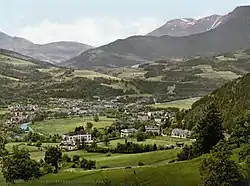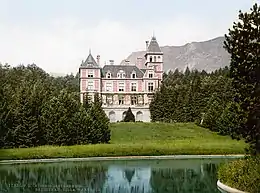Reichenau an der Rax
Reichenau an der Rax is a market town in the Austrian state of Lower Austria, situated at the foot of the Rax mountain range on the Schwarza river, a headstream of the Leitha.
Reichenau an der Rax | |
|---|---|
 Reichenau about 1900 | |
 Coat of arms | |
 Reichenau an der Rax Location within Austria | |
| Coordinates: 47°42′N 15°50′E | |
| Country | Austria |
| State | Lower Austria |
| District | Neunkirchen |
| Government | |
| • Mayor | Johann Döller (ÖVP) |
| Area | |
| • Total | 89.55 km2 (34.58 sq mi) |
| Elevation | 484 m (1,588 ft) |
| Population (2018-01-01)[2] | |
| • Total | 2,571 |
| • Density | 29/km2 (74/sq mi) |
| Time zone | UTC+1 (CET) |
| • Summer (DST) | UTC+2 (CEST) |
| Postal code | 2651 |
| Area code | 02666 |
| Website | www.reichenau.at |
History
Reichenau castle was first mentioned in a 1256 deed. Duke Otto IV the Merry, who in 1327 had established the abbey of Neuberg, acquired Reichenau in 1333 and granted it to the monastery.
Originally an ore mining and forestry area, Reichenau due to its picturesque setting became a summer resort of the Viennese nobility in the 19th century. From 1854 on the development of the area was decisively promoted by the opening of the Semmering railway line with a train station in neighbouring Payerbach, part of the Austrian Southern Railway (Südbahn) from the Vienna Südbahnhof to Trieste. Reichenau was directly connected to Payerbach by the Höllentalbahn narrow gauge railway in 1926 at the same time with the opening of the Raxseilbahn, the oldest aerial tramway in Austria.
In 1873 a drinking water pipeline to Vienna was built to supply the Austro-Hungarian capital with mountain water rising from the Rax range.
.JPG.webp)
In 1872 Archduke Charles Louis of Austria had the Villa Wartholz residence erected near his favourite hunting grounds, according to plans by Heinrich von Ferstel. In 1889 Nathaniel Anselm von Rothschild followed with the building of Hinterleiten Palace. He however did not spend much time in Reichenau and shortly afterwards donated the palais to a veterans foundation, while the Villa Wartholz remained a seat of the Habsburg family, especially of Charles and his wife Zita; their first son, Otto, was born and baptized there,[3] and when Charles become Emperor of Austria, Villa Wartholz was his summer residence in the years 1917 and 1918.
Reichenau was also the summer retreat of the author Heimito von Doderer, where he wrote large parts of his novel Die Strudlhofstiege.
The priest Heinrich Maier, head of the spectacular Austrian resistance group during the Nazi era, was a chaplain in Reichenau in the 1930s. His very successful Catholic resistance group very successfully passed on plans and production facilities for V-1, V-2 rockets, Tiger tanks and aircraft (Messerschmitt Bf 109, Messerschmitt Me 163 Komet, etc.) to the Allies. This enabled the Allies to target decisive armaments factories and to protect residential areas.[4][5][6][7][8]
Notable people
- Otto von Habsburg, head of the House of Habsburg from 1922 to 2006, was born at Villa Wartholz in Reichenau on 20 November 1912.
- Theodor Herzl died in Edlach, a village of Reichenau an der Rax
Transport
Beside the Südbahn railway line, Reichenau can be reached via the B27 Höllental Straße federal highway running from Gloggnitz and the S6 Semmering Schnellstraße expressway to Rohr im Gebirge.
References
- "Dauersiedlungsraum der Gemeinden Politischen Bezirke und Bundesländer - Gebietsstand 1.1.2018". Statistics Austria. Retrieved 10 March 2019.
- "Einwohnerzahl 1.1.2018 nach Gemeinden mit Status, Gebietsstand 1.1.2018". Statistics Austria. Retrieved 9 March 2019.
- "Reichenau an der Rax official website".
- Christoph Thurner "The CASSIA Spy Ring in World War II Austria: A History of the OSS's Maier-Messner Group" (2017), pp 35.
- Elisabeth Boeckl-Klamper, Thomas Mang, Wolfgang Neugebauer: Gestapo-Leitstelle Wien 1938–1945. Vienna 2018, ISBN 978-3-902494-83-2, p 299–305.
- Hans Schafranek: Widerstand und Verrat: Gestapospitzel im antifaschistischen Untergrund. Vienna 2017, ISBN 978-3-7076-0622-5, p 161–248.
- Peter Broucek "Die österreichische Identität im Widerstand 1938–1945" (2008), p 163.
- Hansjakob Stehle "Die Spione aus dem Pfarrhaus (German: The spy from the rectory)" In: Die Zeit, 5 January 1996.
Gallery
 Hirschwang - Villa Schoeller
Hirschwang - Villa Schoeller Hirschwang-Reichenau
Hirschwang-Reichenau Höllental Railway near the Thalhof road
Höllental Railway near the Thalhof road Villa Wartholz
Villa Wartholz Theater
Theater Schlösschen on the Thalhof road
Schlösschen on the Thalhof road Thalhof road - View into the valley to Feuchter
Thalhof road - View into the valley to Feuchter Vicarage, former Villa Doringer
Vicarage, former Villa Doringer_Betriebsgeb%C3%A4ude_in_Reichenau.jpg.webp) Höllental Railway operations building
Höllental Railway operations building Schloss Reichenau
Schloss Reichenau Wartholz Cross
Wartholz Cross Kaiser Fountain
Kaiser Fountain Valley station of the Rax cable car
Valley station of the Rax cable car Top station with restaurant of the Rax cable car
Top station with restaurant of the Rax cable car Waldhütte Villa
Waldhütte Villa